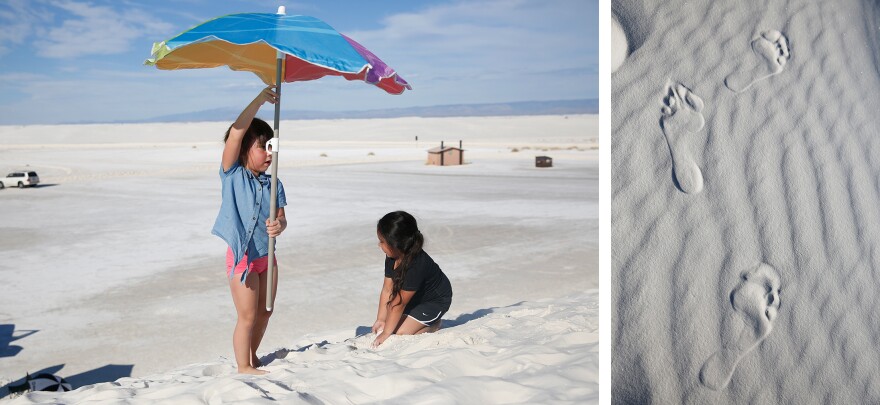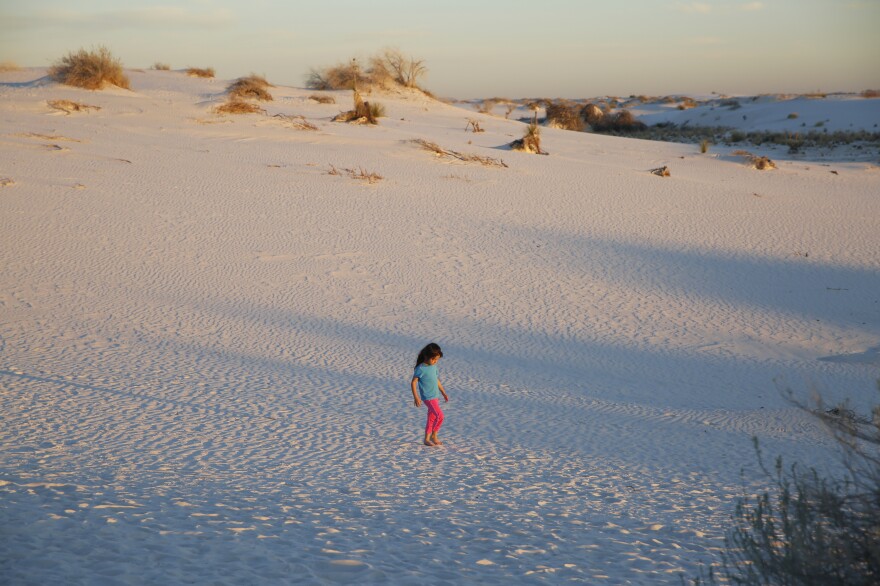Before we headed out on our latest road trip for the Our Land series, we put a call out on social media, asking for ideas of places we should go in Arizona and New Mexico. Shannon Miller's suggestion really caught our attention: "White Sands are the only white gypsum 'sand' dunes in the world. They are actually crystals and it is beautiful."
How could we resist?
There's really no place like it on the planet: White Sands National Monument in southern New Mexico. It's the world's largest gypsum dunefield, miles and miles of stunning white landscape.
Here are some things to know:
1. "Beautiful" — Shannon Miller's description — is an understatement. The landscape is spectacular and otherworldly. "It's like you're in another planet," as park ranger Eugene Ibarra tells us. "The only thing that reminds you that you're still in planet Earth is that the sky is blue."

2. Most of the New Mexico dunefield actually lies outside the boundaries of the park. White Sands National Monument is dwarfed by the White Sands Missile Range, a military testing area for the U.S. Army, and most of the dunefield lies within that missile range. The world's first atomic bomb was detonated at the Trinity test site in the missile range, just 65 miles north of this park, on July 16, 1945. Several weeks later, the U.S. dropped atomic bombs on Hiroshima and Nagasaki.

3. They're not exactly the "only" white gypsum sand dunes in the world, but pretty close. The New Mexico dunes cover a vast area: 275 square miles. The next biggest gypsum dunefield is in Guadalupe Mountains National Park in Texas. Total dunefield area: about 3 square miles.

4. The dunes are made of the soft mineral gypsum, laid down 250 million years ago when the southwestern U.S. was covered by the Permian Sea. Later, that seabed was pushed up into the mountains that ring the basin that surrounds the area. Rainfall dissolves those deposits, carrying the gypsum down and replenishing these sand dunes, which shift constantly with the winds.

5. Even when the sun is broiling hot, the sand stays cool under your bare feet. That's because the sand is made of gypsum crystals.

6. There are signs warning that there's no water available beyond the visitor center, but it's easy to forget just how unforgiving this park can be — because it's so beautiful. And people have died here. Just two summers ago, a mother and a father didn't bring enough water on their hike, and died along the Alkali Flat trail. Their 9-year-old son survived.
7. Because White Sands National Monument is right next to White Sands Missile Range, the park occasionally shuts down during missile testing. The park service also warns visitors to avoid anything that looks like unexploded ordnance. Another neighbor is Holloman Air Force Base. Three years ago, an unmanned drone aircraft from Holloman crashed inside the park, spilling jet fuel and scattering debris. Cleanup and environmental remediation has been slow; that part of the park is still off limits to visitors.
8. Park rangers lead daily sunset strolls through the dunes. Once the sun goes down, the sand gets pretty chilly underfoot. With a permit, you can also go horseback riding through the dunes. It's purely BYOH.
The" Our Land" series is produced by Elissa Nadworny, with production help on this story from Anjuli Sastry.
Copyright 2020 NPR. To see more, visit https://www.npr.org.




